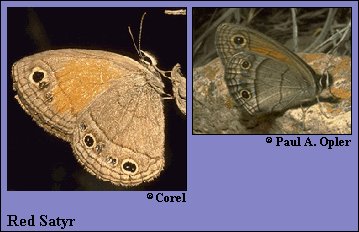 |
 

 |



Red Satyr (Megisto rubricata [W. H. Edwards])
Wing span: 1 3/8 - 1 7/8 inches (3.5 - 4.8 cm).
Identification: Upperside is dark brown; each wing has 1 eyespot and a reddish patch. Underside is light brown; forewing has a reddish patch and 1 eyespot near the tip.
Life history: Males patrol in shady areas for females. Eggs are scattered on dead leaves or near grass blades. Caterpillars eat grass blades and mature caterpillars hibernate.
Flight: Two broods from April-September.
Caterpillar hosts: Bermuda grass (Cynodon dactylon) and St. Augustine grass (Stenotaphrum secundatum).
Adult food: Not reported.
Habitat: Open mesquite, juniper, or oak-pine woodland.
Range: Central Arizona, central New Mexico, east Texas, and south-central Kansas south through Mexico to Guatemala.
Conservation: Not usually required.
The Nature Conservancy Global Rank: G5 - Demonstrably secure globally, though it may be quite rare in parts of its range, especially at the periphery.
Management needs: None reported.
References:
Bailowitz, R. A., and J. P. Brock. 1991. Butterflies of southeastern Arizona.
Sonoran Arthropod Studies, Inc., Tucson, Arizona. 342 pages.
Opler, P. A. and V. Malikul. 1992. A field guide to eastern butterflies. Peterson
field guide #4. Houghton-Mifflin Co., Boston. 396 pages, 48 color plates.
Scott, J. A. 1986. The butterflies of North America. Stanford University Press,
Stanford, Calif. 583 pages, 64 color plates.
Author: Jane M. Struttmann

